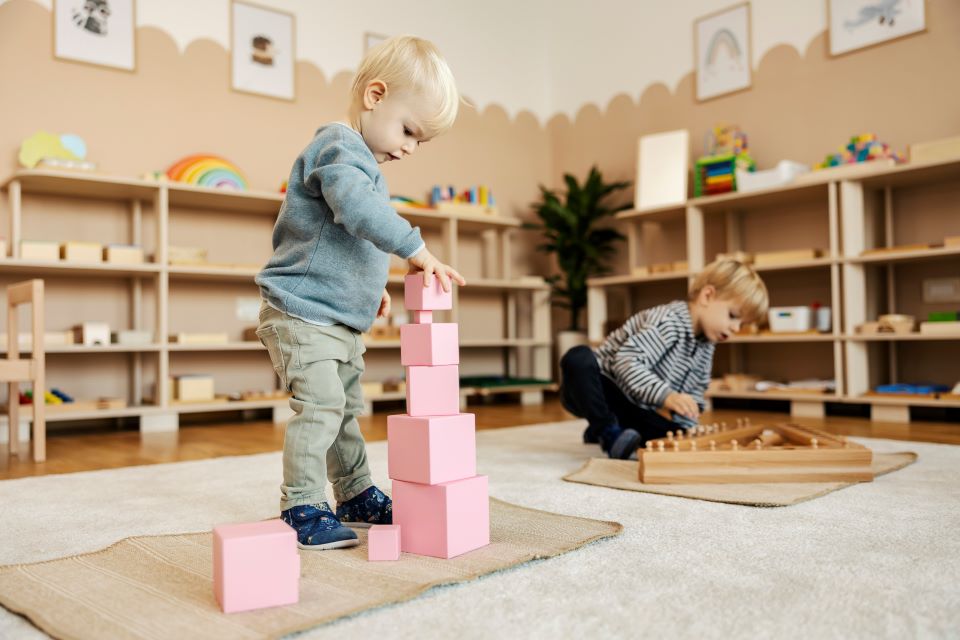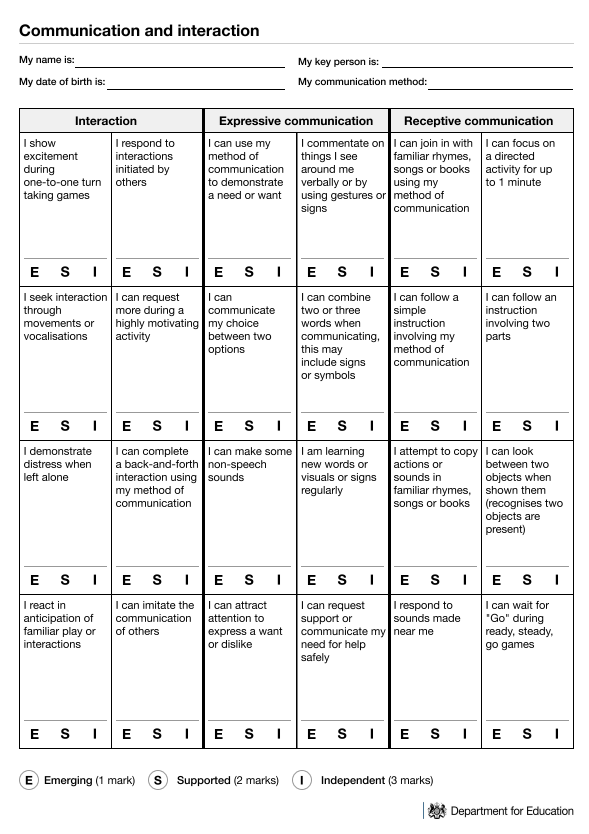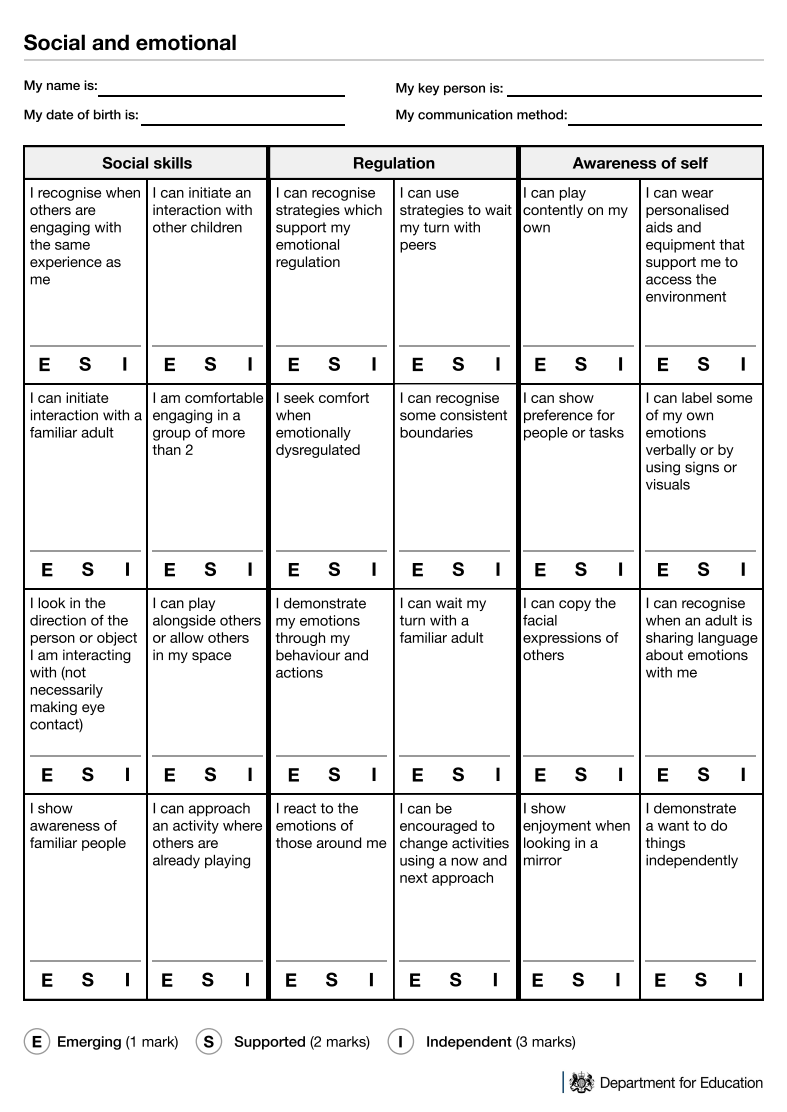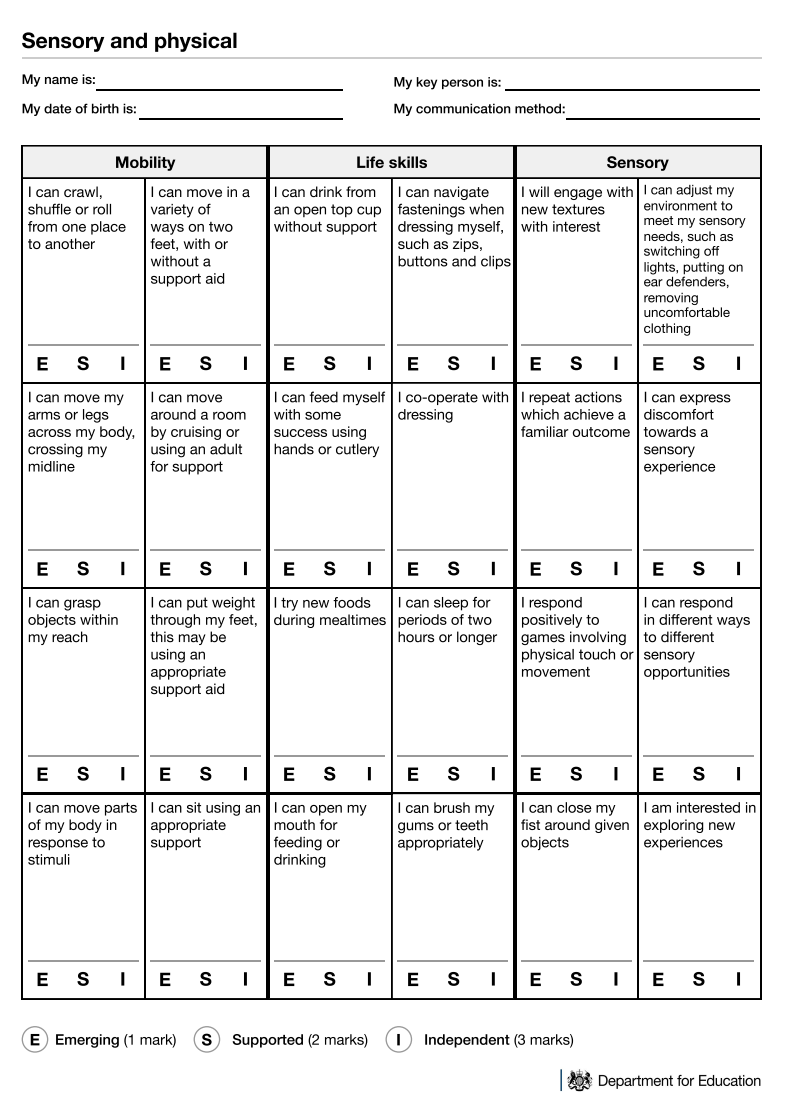Using the assessment tools
Examples of how to use the assessment tools in practice including a one-page profile and a SMART targets sheet.
The DfE assessment resources provide a suggested way of working when assessing children with SEND in the early years. Whether you are a school-based provider, group-based provider or childminder, these resources can be used to support your children with potential or known SEND. You may want to use everything, or choose which specific elements will be helpful for your setting.
The resources include:
- four assessment tools centred around the four broad areas of need
- examples of how to use the assessment tools in practice
- a one page profile to capture the voice of the child
- SMART targets sheet to set short-term targets
- support and achievement play plans (SAPPs) to capture a child’s long-term goals and needs
The assessment tools
There are four assessment tools, that reflect the four broad areas of need, with a focus on the core skills children with SEND may gain in each area. You can use them at any stage of supporting a child, and they are designed to be used individually or together based on the needs of a child.
The tools may be used in the following way:
- An area of need is recognised through observation and discussed with the parents and or carers.
- The appropriate broad area(s) of need is selected from the assessment tools.
- You use the tool to find out what the child can do in their area of need.
- You discuss the child’s strengths and strategies to support them and note this on a one-page profile with the parents and or carers.
- You use the assessment tool to outline the initial targets for their child. Using specific, measurable, achievable, relevant and time-bound (SMART) targets you can help a child to make progress towards the assessment statements within the tool.
- You may want to produce a Support and Achievement Play Plan (SAPP), which will identify long-term goals and record key strategies you may use to support the child. You implement the strategies discussed in practice, noting their impact on the child and how the child engages with your planned support.
- By the end of the term, or appropriate period, you review the impact of the strategies with the parents and or carers, complete a development monitoring review to determine developmental progress and set out new appropriate targets.
- Repeat steps 5-7 until you feel support is no longer required or you support the child to transition to their next setting or school.
There may come a time where you feel external specialist support is required. You may refer to your setting or local authority area Special Educational Needs Co-Ordinator (SENCO) for support and guidance or you can directly refer to these services and work with them on any additional support to be implemented. You should only request specialist support when you are satisfied that you have used a graduated approach to understand the child and their needs, and even when they are waiting to be seen you should continue to trial different approaches to support the child.
To strengthen your understanding of how to identify developmental differences and needs and help to consider factors affecting children’s development when they access the learning and curriculum on offer, the DfE has developed early years child development training. You can access it for free.
Using the assessment tools

Completing the assessment tool is quick and simple. Each statement is broken down into three levels:
- emerging – the child is showing some interest or awareness of this skill.
- supported – the child can achieve this skill with support from another (adult or child).
- independently – the child can consistently achieve this skill on their own without additional support from an adult or child.
By reading the statements you can make a judgement as to whether you feel the child is not yet showing awareness of this skill, and so leave it unmarked, or determine whether they are emerging (E), supported (S) or independent (I). You can then mark the coordinating letter however you wish (circle, highlight, tick, etc.).
Every time you complete an additional review you should use a different colour to evidence where you feel the child is at that point. We recognise that some children may regress with their development on occasion, and this should also be marked, and appropriate next steps and intervention should be carried out.
The assessment tools promote a positive view of the child by working towards a series of “I can” statements. These are further divided into three sub sections, which allow you to see if there are particular areas of development that may need deeper focus. The statements are organised like building blocks, with the likelihood that the lower blocks are achieved before the higher blocks. However, some children will not progress in this way, and you should not be concerned if you are observing that the higher blocks have been achieved before the lower blocks.
You can also note the types of play you observe from the child to support your decision making in appropriate strategies of support or environmental adjustments you can make to enhance their learning.
Case study
 Mary completed the “Sensory and Physical” tool for Abdul, and noted that he is not yet using an open top cup and preferred drinking from a closed ‘easy drink’ bottle. She circled “E” (emerging) on the statement “I can drink with an open top cup without support”. To support him, Mary planned to initially provide Abdul with a slanted, 2 handled drinks cup, alongside his favourite bottle, which gave him the access to an open cup whilst being easier to hold and needing little movement backwards to drink. She shared these next steps with other practitioners and Abdul’s parents so that at meal and snack times Abdul will be supported by an adult to engage and drink from the open cup ensuring consistency between home and setting. She also noted this down on his SMART target sheet. Mary also decided to offer other tipping and pouring opportunities for Abdul throughout his play to encourage these skills in the moment. She modelled tipping and pouring actions with Abdul throughout the session when he showed an interest in the water tray. Throughout the term, his confidence grew, and his skills developed. By the following term, when Mary completed the assessment tool for Abdul again, she was able to recognise his progress by circling “S” (supported), indicating that he can now demonstrate this skill with guidance from an adult.
Mary completed the “Sensory and Physical” tool for Abdul, and noted that he is not yet using an open top cup and preferred drinking from a closed ‘easy drink’ bottle. She circled “E” (emerging) on the statement “I can drink with an open top cup without support”. To support him, Mary planned to initially provide Abdul with a slanted, 2 handled drinks cup, alongside his favourite bottle, which gave him the access to an open cup whilst being easier to hold and needing little movement backwards to drink. She shared these next steps with other practitioners and Abdul’s parents so that at meal and snack times Abdul will be supported by an adult to engage and drink from the open cup ensuring consistency between home and setting. She also noted this down on his SMART target sheet. Mary also decided to offer other tipping and pouring opportunities for Abdul throughout his play to encourage these skills in the moment. She modelled tipping and pouring actions with Abdul throughout the session when he showed an interest in the water tray. Throughout the term, his confidence grew, and his skills developed. By the following term, when Mary completed the assessment tool for Abdul again, she was able to recognise his progress by circling “S” (supported), indicating that he can now demonstrate this skill with guidance from an adult.
Here is an example of a completed tool
Example tool
Using the framework tool to monitor child progress
Monitoring how children progress with their learning helps you see where to focus your support. The development growth section enables you to note how a child is progressing over a period of time, recognising areas where the child may need further support and areas in which they are making continuous developmental progress and so highlighting their strengths.
This can be simply monitored by recording the number of emerging, supported or independent statements a child is achieving. For example, where a child is emerging in a statement this would be recorded as 1, supported would be 2 and independent would be 3, you can add these together to see how much of the assessment tool they are covering with each review, monitoring their progress.
You can monitor a child’s progress through the change in the number of statements a child is covering within the assessment tool each term.
Using the framework following the Progress Check at Age Two
If a delay is identified during the Progress Check at Age Two, you may choose to use the assessment tool as your next step on the journey to supporting the child and their parents and or carers. You can select and complete the relevant tool to understand in more detail what the child is currently achieving. This way, you create a starting point to work from and this supports you in evidencing the successes a child has with the intervention you can provide.
Case study
After completing the Progress Check at Age Two with his key child, Leigh, Mathew recognised that her communication and language skills were delayed. He met with Leigh’s parents to discuss how they could further support her, and introduced the setting SENCO. They chose the communication and interaction tool and completed an assessment of Leigh. This assessment, alongside conversation with her parents to understand more about how Leigh communicates at home, led to identifying that Leigh could use some early speech sounds, but lacked confidence when engaging with others.
Mathew decided to use visuals alongside Leigh’s favourite interests and used simple language during play as first strategies to support Leigh’s communication journey moving forwards. Mathew engaged in these strategies with Leigh consistently, and shared the same visuals with her parents to use in the home. Over time both parents and Mathew noticed an increase in awareness of the visuals and on occasion Leigh would pick up a visual which linked with something she was playing with. By the next review, a term later, everyone could see the progress in Leigh’s awareness of communication.
Through the reviews and communal discussion of Leigh’s strengths and needs the team that surrounded her could identify strategies that would interest her as well as support her early language skills which led to effective progress being made on each termly review. If Leigh’s communication needs continue to make progress but not meet typical milestones the SENCO would support the family in making a referral to speech and language services in their area for additional support and guidance.
Using the toolkit to support accessing funding
Additional funding can be important to ensuring equipment, training and appropriate support are in place. When applying for local authority allocated funding, they may ask you for evidence of the child’s need. To access funding, it should be clear what broad areas of need a child has, how this impacts their learning and development, the support currently in place and the potential impact of the support requested. The impact on a child’s learning and development can be evidenced through selecting observations that demonstrate the child’s needs and how effective the current support provided is. By using the assessment tool, you can show clear progression through small steps-based learning. These are all things that a local authority may consider when assessing applications for SEND funding.





